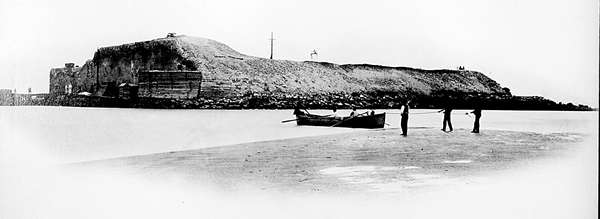Thomaston
First Cannon Ball Fired, Confederate Memorials
Courthouse Square, Thomaston
Perhaps the most unique artifact of the Civil War is found, not in any museum,
but out in the open, braving the elements, on a courthouse lawn attached to
a marble base, the "First Cannon Ball Fired at Outbreak of the War Between
the States at Fort Sumter ,
April 12, 1861." An engraving on the base tells the story of the cannon
ball: It was "Presented to the UDC by Mrs. Sallie White to whom it was
given in 1861 by P.W. Alexander, leading Confederate war correspondent who was
present when the ball was fired and knew it to be the first. The first marker
stating these facts was erected on this square in 1919." The courthouse
has several other memorials to the Civil War,
including a marker noting Upson County as the birthplace of famed Gen. John
B. Gordon; A Woodmen of the World memorial to the Upson County men who were
missing in action in the Civil War; and an Upson County Confederate monument.
On April 17, Union cavalry, Wilson's Raiders, surprised 50 Confederates guarding
Double Bridges over the Flint in Upson County, and marched to Thomaston where
they destroyed three textile factories and a train filled with Confederate stores.
Late on the 19th, a train unwittingly arrived from Macon, only to be seized
by the Raiders. On the train were newspapers whose news sent cheers roaring
through the Yankees. Lee had surrendered to Grant!
,
April 12, 1861." An engraving on the base tells the story of the cannon
ball: It was "Presented to the UDC by Mrs. Sallie White to whom it was
given in 1861 by P.W. Alexander, leading Confederate war correspondent who was
present when the ball was fired and knew it to be the first. The first marker
stating these facts was erected on this square in 1919." The courthouse
has several other memorials to the Civil War,
including a marker noting Upson County as the birthplace of famed Gen. John
B. Gordon; A Woodmen of the World memorial to the Upson County men who were
missing in action in the Civil War; and an Upson County Confederate monument.
On April 17, Union cavalry, Wilson's Raiders, surprised 50 Confederates guarding
Double Bridges over the Flint in Upson County, and marched to Thomaston where
they destroyed three textile factories and a train filled with Confederate stores.
Late on the 19th, a train unwittingly arrived from Macon, only to be seized
by the Raiders. On the train were newspapers whose news sent cheers roaring
through the Yankees. Lee had surrendered to Grant!
- U.S. 19 to Thomaston. U.S. 19 turns into Church St. and runs in front
of the courthouse.
Confederate Cemeteries
Glenwood Cemetery: Off E. Lee St., Thomaston
The Rock Confederate Cemetery: The Rock Rd., The Rock
Thomaston, a cotton mill town on the Flint River located on a spur off the Macon
and Western Railroad, was the location of two Confederate hospitals, the Newsom
and Frank Ramsey, and several temporary hospitals. A Confederate cemetery
holds 54 soldiers, six unknown, who died in these hospitals. The grave
of Dr. Edward A. Flewellen, a noted Confederate surgeon and Medical Director
for the Army of Tennessee, is near this spot. The Rock also has a Confederate
Cemetery.
Read
and add comments about this page
Reader-Contributed Links to the Civil War in Georgia Book:
 ,
April 12, 1861." An engraving on the base tells the story of the cannon
ball: It was "Presented to the UDC by Mrs. Sallie White to whom it was
given in 1861 by P.W. Alexander, leading Confederate war correspondent who was
present when the ball was fired and knew it to be the first. The first marker
stating these facts was erected on this square in 1919." The courthouse
has several other memorials to the Civil War,
including a marker noting Upson County as the birthplace of famed Gen. John
B. Gordon; A Woodmen of the World memorial to the Upson County men who were
missing in action in the Civil War; and an Upson County Confederate monument.
On April 17, Union cavalry, Wilson's Raiders, surprised 50 Confederates guarding
Double Bridges over the Flint in Upson County, and marched to Thomaston where
they destroyed three textile factories and a train filled with Confederate stores.
Late on the 19th, a train unwittingly arrived from Macon, only to be seized
by the Raiders. On the train were newspapers whose news sent cheers roaring
through the Yankees. Lee had surrendered to Grant!
,
April 12, 1861." An engraving on the base tells the story of the cannon
ball: It was "Presented to the UDC by Mrs. Sallie White to whom it was
given in 1861 by P.W. Alexander, leading Confederate war correspondent who was
present when the ball was fired and knew it to be the first. The first marker
stating these facts was erected on this square in 1919." The courthouse
has several other memorials to the Civil War,
including a marker noting Upson County as the birthplace of famed Gen. John
B. Gordon; A Woodmen of the World memorial to the Upson County men who were
missing in action in the Civil War; and an Upson County Confederate monument.
On April 17, Union cavalry, Wilson's Raiders, surprised 50 Confederates guarding
Double Bridges over the Flint in Upson County, and marched to Thomaston where
they destroyed three textile factories and a train filled with Confederate stores.
Late on the 19th, a train unwittingly arrived from Macon, only to be seized
by the Raiders. On the train were newspapers whose news sent cheers roaring
through the Yankees. Lee had surrendered to Grant!